Un vivido EarthCache con grandi fossili sulla pista Ciclovia Alpe Adria
Ein anschaulicher EarthCache mit tollen Fossilien am Alpe Adria Radweg
A vivid EarthCache with great fossils on the Alpe Adria bike path
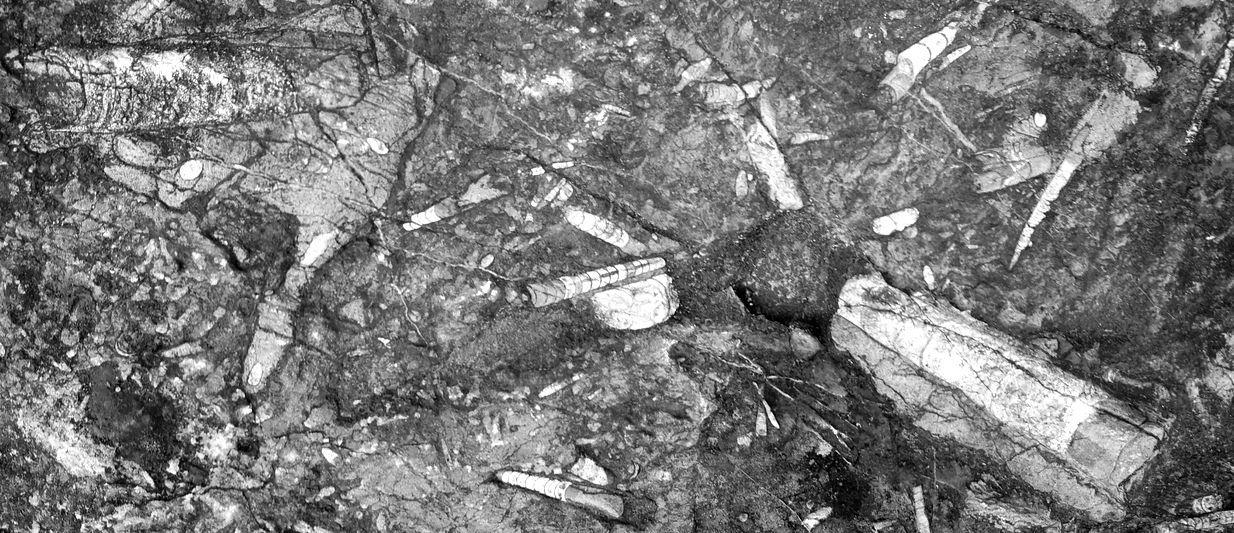
[IT] La geologia delle Alpi calcaree meridionali
Pontebba si trova nelle Alpi calcaree meridionali all'interfaccia tra le Alpi Giulie, la dorsale principale carnica e le Alpi carniche meridionali. Mentre le Alpi centrali sono costituite principalmente da roccia cristallina (granito, gneiss, ardesia cristallina), le Alpi calcaree sono fatte di calcare più leggero e più poroso. Centinaia di milioni di anni fa, questa regione non era una catena montuosa, ma un mare brulicante di vita. Le Alpi Carniche sono tra le 100 regioni geologiche più importanti della terra. In nessuna parte d'Europa le aree di sviluppo del mare profondo, i margini continentali e le lagune coralline del mondo antico sono così vicine. La conservazione dei fossili esistenti è notevole nonostante le molteplici pieghe delle montagne. I geologi vengono regolarmente da tutto il mondo per dare un'occhiata a questo fenomeno sul posto.
[DE] Die Geologie der Südlichen Kalkalpen
Pontebba liegt in den Südlichen Kalkalpen an der Schnittstelle zwischen den Julischen Alpen, dem Karnischen Alpenhauptkamm sowie den Südlichen Karnischen Alpen. Während die Zentralalpen meist aus Kristallingestein (Granit, Gneis, kristalline Schiefer) bestehen, sind die Kalkalpen aus hellerem und poröserem Kalkstein aufgebaut. Diese Region war vor hunderten Millionen Jahren noch kein Gebirge, sondern ein vor Leben nur so wimmelndes Meer. Die Karnischen Alpen gehören zu den 100 wichtigsten geologischen Regionen der Erde. Nirgendwo in Europa sind die Entwicklungsräume des tiefen Meeres, der Kontinentalränder und der Rifflagunen des Erdaltertums so nahe zusammengerückt. Die Erhaltung der vorhandenen Fossilien ist trotz der mehrfachen Gebirgsfaltung bemerkenswert. Aus der ganzen Welt kommen regelmäßig Geologen, um sich dieses Phänomen vor Ort anzusehen.
[EN] The geology of the Southern Limestone Alps
Pontebba is located in the Southern Limestone Alps at the interface between the Julian Alps, the Carnic main crest and the Southern Carnic Alps. While the Central Alps mostly consist of crystalline rock (granite, gneiss, crystalline slate), the Limestone Alps are made up of lighter and more porous limestone. Hundreds of millions of years ago, this region was not a mountain range, but a sea teeming with life. The Carnic Alps are among the 100 most important geological regions on earth. Nowhere in Europe have the development areas of the deep sea, the continental margins and the reef lagoons of the ancient world come so close together. The preservation of the existing fossils is remarkable despite the multiple mountain folds. Geologists regularly come from all over the world to take a look at this phenomenon on site.
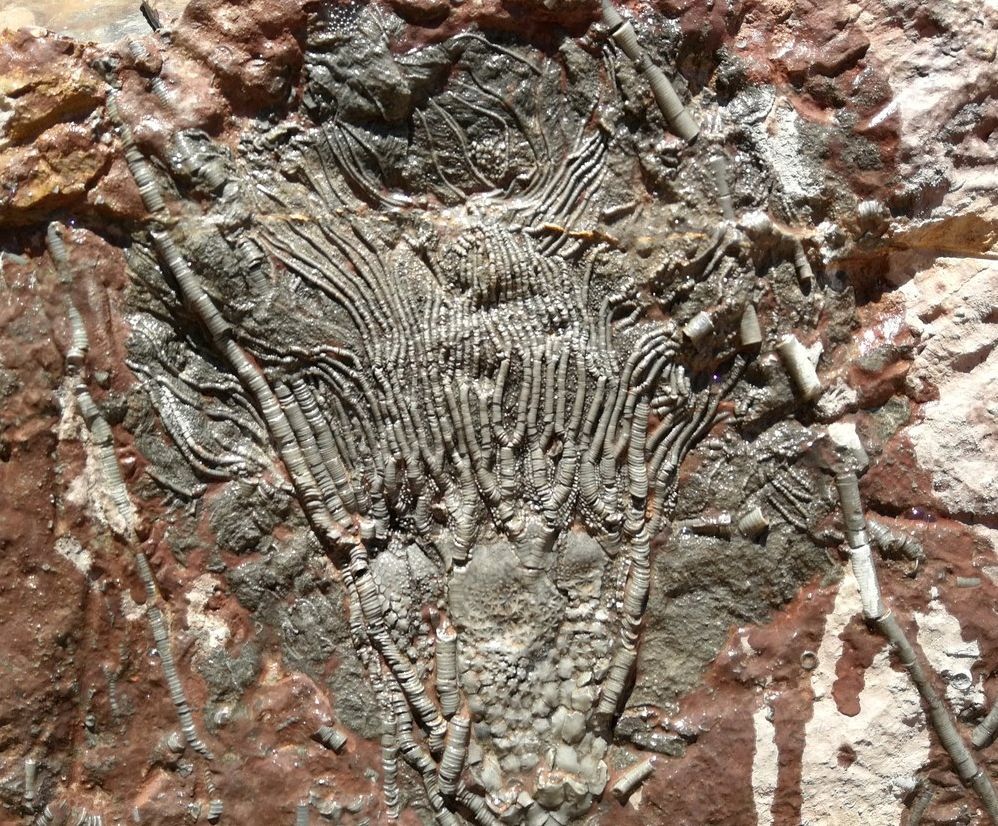
Fossil in the limestone of the Devonian
[IT] Come nascono i fossili?
Quando un animale muore, le parti molli del corpo, come la pelle e gli organi, si decompongono prima. Lo scheletro è conservato molto più a lungo. Se una pianta morta o le ossa di un animale sono coperte di fango, vengono sigillate ermeticamente. Il materiale organico non può ulteriormente degradare perché manca l'ossigeno. Se nel corso del tempo si depositano più strati di terra di sabbia, ghiaia, fango o altro materiale terrestre, si verifica una pressione più elevata. Questo avvia la pietrificazione degli organismi. Questo processo richiede molto tempo, fino a diversi milioni di anni. I fossili creati in questo modo inizialmente si trovano molto in profondità nella terra. Tuttavia, tornano sulla superficie della terra attraverso la formazione rocciosa (sviluppo geologico) e la rimozione della roccia dal vento e dall'acqua (erosione). Ecco perché oggi possiamo ammirare i resti di piante primordiali o animali come i dinosauri sotto forma di fossili.
[DE] Wie entstehen Fossilien?
Wenn ein Tier stirbt, verwesen zuerst die weichen Teile des Körpers, wie zum Beispiel die Haut und die Organe. Das Skelett bleibt sehr viel länger erhalten. Wenn eine abgestorbene Pflanze oder Knochen eines Tieres von Schlamm bedeckt werden, werden diese dadurch luftdicht abgeschlossen. Das organische Material kann nicht weiter zerfallen, weil der Sauerstoff fehlt. Wenn im Laufe der Zeit weitere Erdschichten aus Sand, Kies, Schlamm oder anderem Erdmaterial darüber abgelagert werden, entsteht ein höher werdender Druck. Dadurch beginnt die Versteinerung der Organismen. Dieser Prozess dauert sehr lange – bis zu mehreren Millionen Jahren. Die so entstandenen Fossilien liegen zunächst sehr tief in der Erde. Sie gelangen aber durch Gebirgsbildung (geologische Auffaltung) und das Abtragen von Gestein durch Wind und Wasser (Erosion) wieder an die Oberfläche der Erde. Darum können wir heute die Überreste von urzeitlichen Pflanzen oder Tieren wie Dinosauriern in Form von Fossilien bewundern.
[EN] How do fossils arise?
When an animal dies, the soft parts of the body, such as the skin and organs, decompose first. The skeleton is preserved much longer. If a dead plant or an animal's bones are covered by mud, they are sealed airtight. The organic material cannot decay further because the oxygen is missing. If more layers of earth made of sand, gravel, mud or other earth material are deposited over the course of time, a higher pressure arises. This starts the petrification of the organisms. This process takes a very long time - up to several million years. The fossils created in this way initially lie very deep in the earth. However, they get back to the surface of the earth through rock formation (orogeny) and the removal of rock by wind and water (erosion). That is why today we can admire the remains of primeval plants or animals such as dinosaurs in the form of fossils.
[IT] Quali animali vivevano qui? Quali fossili si possono trovare?
Di fronte alle immagini degli animali sul muro ci sono rocce con i fossili di Orthoceras, Crinoide e Gastropoda.
[DE] Welche Tiere haben hier gelebt? Welche Fossilien konnten gefunden werden?
Vor den Bildern der Tiere an der Wand sind Gesteine mit den Fossilien von Orthoceras, Crinoide und Gastropoda ausgestellt.
[EN] What animals lived here? Which fossils could be found?
In front of the pictures of the animals on the wall are rocks with the fossils of Orthoceras, Crinoide and Gastropoda.
Orthoceras
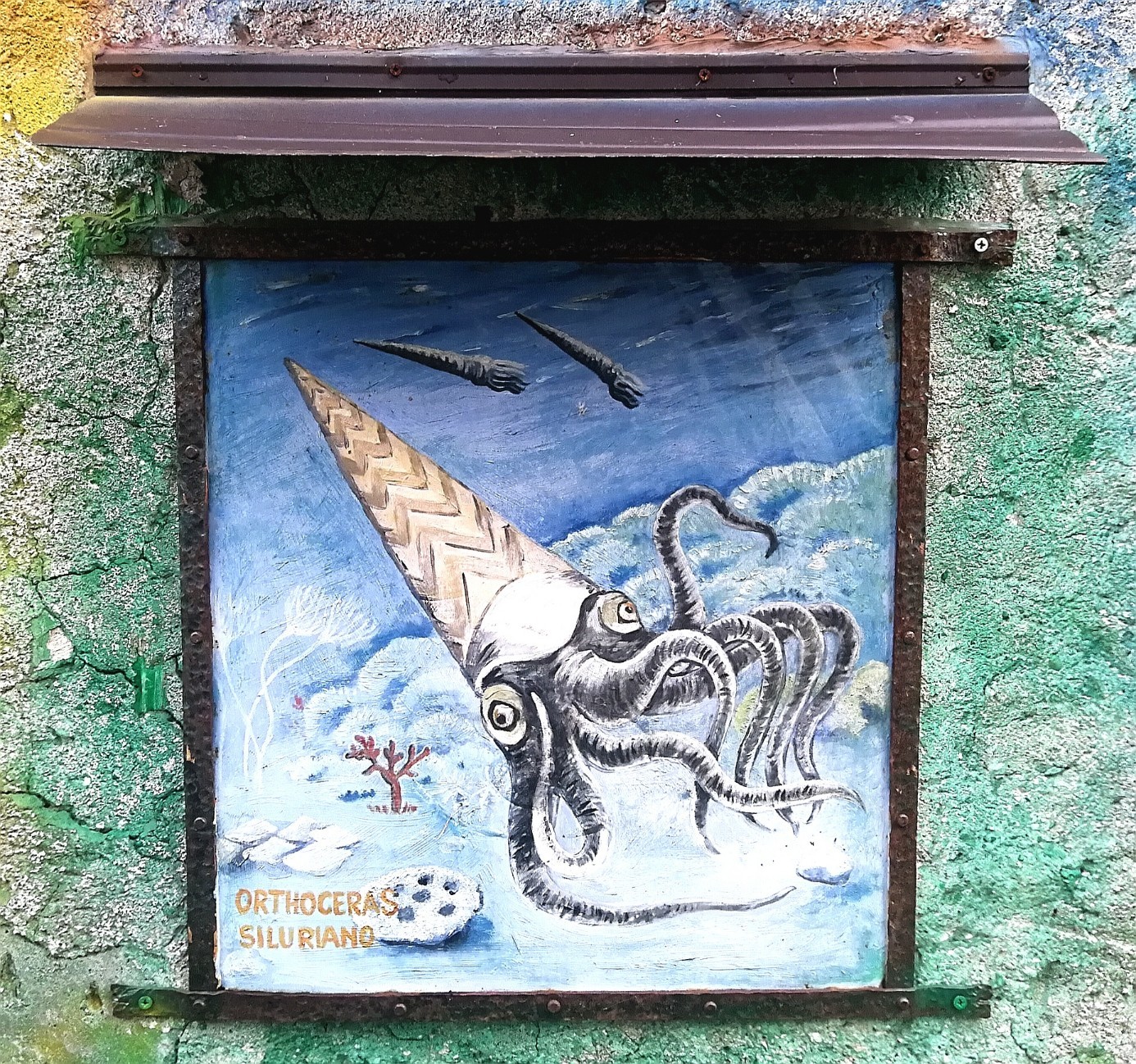
[IT] Le ortocere vivevano in acqua e talvolta sono chiamate "calamari preistorici". Il corpo cilindrico - la dimora dell'Ortocera - era aperto nell'ampia parte anteriore. L'animale poteva quindi muovere la testa in caso di pericolo o per l'ingestione del cibo. Questi animali non esistono più oggi, si sono conservati solo i gusci in cui alloggiavano, mentre le parti molli si sono decomposte. La lunghezza di questi fossili simili a corna varia da un centimetro fino a quattro metri.
[DE] Orthoceras haben früher im Wasser gelebt und werden gelegentlich auch "Ur-Tintenfisch" genannt. Der zylinderartige Körper - die Behausung der Orthocera - war im vorderen, weiten Bereich offen. Das Tier konnte bei Gefahr und Aufnahme von Nahrung den Kopf einziehen. Von den heute nicht mehr existenten Tieren sind lediglich die Gehäuse erhalten, die Weichteile wurden zersetzt. Die Länge der hornartigen Fossilien reicht von einem Zentimeter bis zu vier Metern.
[EN] Orthoceras used to live in the water and are sometimes called "prehistoric squid". The cylindrical body - the dwelling of the Orthocera - was open in the front, wide area. The animal could move its head when there was danger and ingestion of food. Of the animals that no longer exist today, only the housings are preserved, the soft parts have been decomposed. The length of the horn-like fossils ranges from one centimeter to four meters.
Crinoide
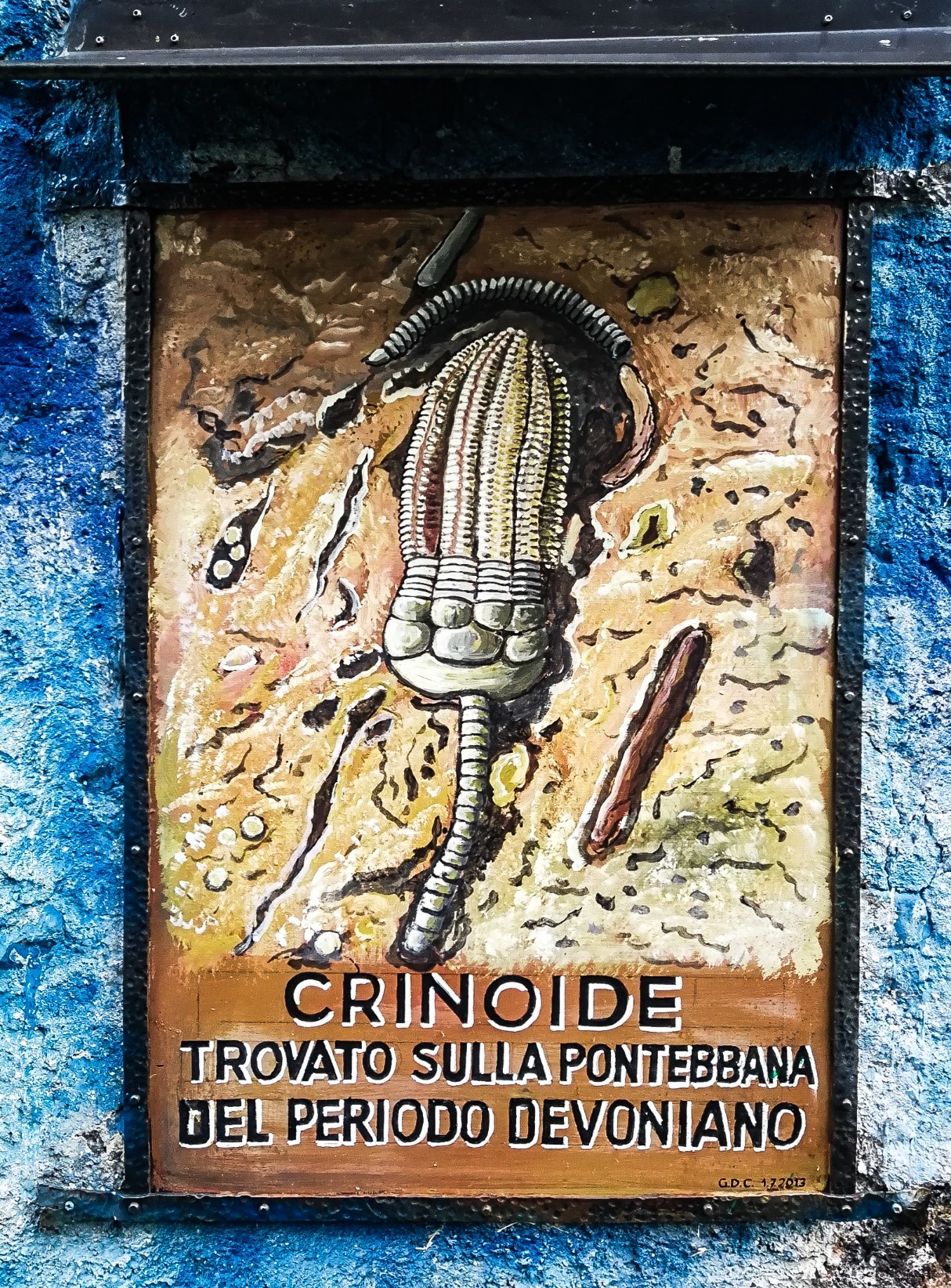
[IT] I crinoidi sono gigli di mare e stelle marine pimate. La maggior parte delle specie di questi animali sono attaccate al fondo del mare con uno stelo e a cui è attaccata una struttura a forma di calice nella parte superiore, con alcune piastre ossee che proteggono il corpo molle dell'animale. Oltre alle forme fisse nel terreno, esistevano anche gigli di mare galleggianti. Dal bordo della struttura a calice si diramavano cinque braccia. La parte iniziale delle braccia si divideva per formare 10 o 20 braccia più piccole, a forma di corona. Con l'aiuto di queste braccia piumate, filtravano il plancton e lo portavano alla bocca. I gigli di mare sono comparsi dall'Ordoviciano e, ad eccezione delle stelle marine piumate, vivono solo nelle acque profonde a sud dell'equatore ("fossili viventi").
[DE] Crinoide sind Seelilien und Haarsterne. Die meisten Arten dieser Tiere sind mit einem Stiel am Meeresboden befestigt und tragen am oberen Ende einen mit Plattenkränzen aufgebauten Kelch, der den Weichkörper des Tieres schützt. Neben den festsitzenden Formen kommen auch frei schwimmende Seelilien vor. Vom Kelchrand aus verzweigen sich zunächst fünf Arme. Durch weitere Teilung der Armbasen entstehen 10- oder auch 20-armige Kronen. Mit Hilfe von fiederartigen Armansätzen filtern sie Plankton und befördern ihn in ihren Mund. Die Seelilien treten seit dem Ordovizium auf und leben, mit Ausnahme der Haarsterne, heute nur noch im Tiefseebereich südlich des Äquators („Lebende Fossilien“).
[EN] Crinoids are sea lilies and hair stars. Most species of these animals are attached to the sea floor with a stem and carry a goblet with plate wreaths at the top that protects the animal's soft body. In addition to the fixed shapes, there are also free-floating sea lilies. Five arms branch out from the edge of the chalice. By further dividing the arm bases, 10 or 20 arm crowns are created. With the help of feathery arms, they filter plankton and put it in their mouth. The sea lilies have appeared since the Ordovician period and, with the exception of the hair stars, only live in the deep-sea area south of the equator ("living fossils").
Gasteropodi
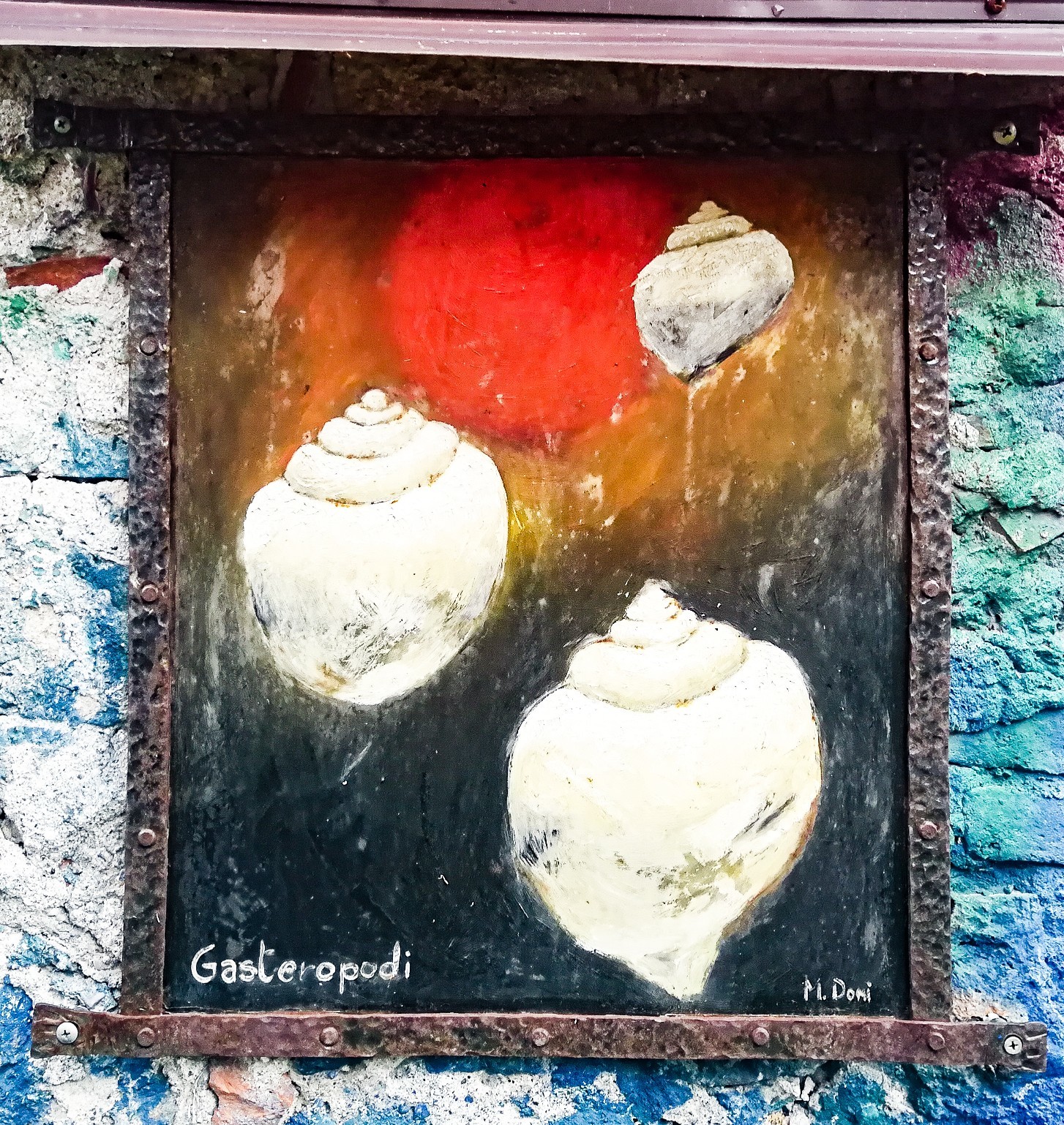
[IT] Esistono numerosi tipi di lumache (gastropoda); alcuni vivono nell'acqua, altri sulla terra. La conchiglia delle lumache, nota come guscio a chiocciola, è fatto di una sostanza calcarea (carbonato di calcio) come gli altri molluschi a guscio. Tuttavia, differisce in modo significativo da questi per il suo avvolgimento a spirale asimmetrico e può quindi essere distinto dal guscio di una qualsiasi conchiglia. Le più antiche lumache fossili risalgono al primo Cambriano circa 530 milioni di anni fa.
[DE] Es gibt zahlreiche Arten von Schnecken (Gastropoda); manche leben im Wasser, andere auf dem Land. Die als Schneckenhaus bekannte Schale der Schnecken besteht wie bei den übrigen Schalenweichtieren aus Kalk (Calciumcarbonat). Sie unterscheidet sich aber durch ihre asymmetrisch spiralige Windung deutlich von diesen und kann so von der Schale einer Muschel unterschieden werden. Älteste fossile Schnecken stammen dem frühen Kambrium vor ca. 530 Millionen Jahren.
[EN] There are numerous types of snails (gastropoda); some live in the water, others in the country. The shell of the snails, known as the snail shell, is made of lime (calcium carbonate) like the other shell molluscs. However, it differs significantly from these by its asymmetrical spiral winding and can thus be distinguished from the shell of a shell. The oldest fossil snails date from the early Cambrian about 530 million years ago.
[IT] Cos'è la cronostratigrafia geologica?
Sul posto troverete anche un pannello informativo con una tabella crono-stratigrafica, sulla quale alcune specie animali sono assegnate ai rispettivi periodi geologici. Alcuni fossili caratteristici - i cosiddetti fossili guida - consentono di determinare l'età delle rocce, ma i fossili guida, per essere tali, devono essere esistiti solo per un breve periodo al fine di consentire la datazione più accurata possibile. Dovrebbero anche essere molto diffusi e chiaramente identificabili.
[DE] Was ist geologische Chronostratigraphie?
Vor Ort findet ihr auch eine Infotafel zur Chronostrafigrafie, auf der bestimmte Tierarten den jeweiligen erdgeschichtlichen Zeiträumen zugeordnet werden. Durch charakteristische Fossilien - sogenannte Leitfossilien - ist die Altersbestimmung von Gesteinen möglich. Leitfossilien dürfen jedoch nur kurze Zeit existiert haben, um eine möglichst präzise Datierung zu ermöglichen. Außerdem sollten sie leicht und eindeutig bestimmbar sein.
[EN] What is geological chronostratigraphy?
On site you will also find an information board of chronostratigraphy, on which certain animal species are assigned to the respective geological periods. Characteristic fossils - so-called index fossils - make it possible to determine the age of rocks, but guiding fossils may only have existed for a short time in order to enable the most precise dating possible. They should also be easy and clearly identifiable.
Sources:
Wikipedia
steine-und-minerale.de
discoveralpigiulie.eu
[IT] Le domande
1. Descrivi l'aspetto dei fossili delle tre diverse specie animali che si possono vedere qui: quali forme hanno, quanto sono grandi, di che colore sono i fossili e la roccia?
2. Quali parti del corpo dell'animale sono state pietrificate e quali no?
3. L'età della roccia può essere determinata in base alla presenza di Gasteropodi?
4. Scatta una foto di te o di un oggetto personale alle coordinate della lista.
[DE] Die Fragen
1. Beschreibe das Aussehen der Fossilien der drei unterschiedlichen Tierarten, die hier zu sehen sind: Welche Formen haben sie, wie groß sind sie, welche Farbe haben die Fosilien und das Gestein?
2. Welche Körperteile der Tiere sind versteinert worden und welche nicht?
3. Kann anhand des Vorkommens von Gasteropodi das Alter des Gesteins bestimmt werden?
4. Mache bitte ein Foto von dir oder einem persönlichen Gegenstand an den Listing-Koordinaten.
[EN] The Questions
1. Describe the appearance of the fossils of the three different animal species that can be seen here: what shapes do they have, which size do they have, what color are the fossils and the rock?
2. Which parts of the animal's body have been petrified and which have not?
3. Can the age of the rock be determined based on the occurrence of Gasteropodi?
4. Please take a photo of yourself or a personal item at the listing coordinates.
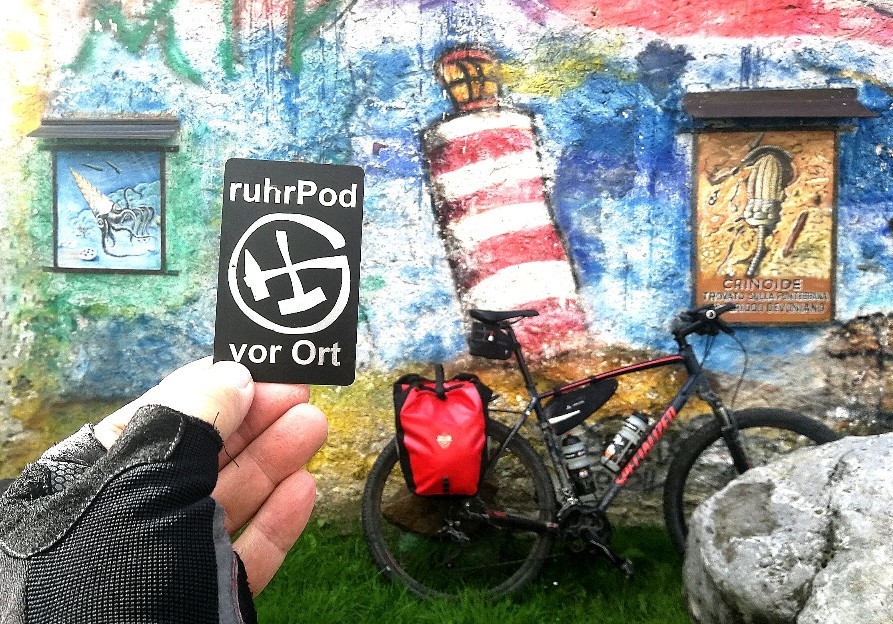
Logproof
Log the EarthCache:
[IT] Vi prego di inviarmi le risposte a tutte le domande tramite il modulo di contatto del mio profilo GC o la funzione di messaggio; puoi quindi accedere direttamente (non dimenticare la tua foto!). Non è necessario attendere il rilascio di un registro. Se qualcosa non va, ti contatterò.
[DE] Sendet mir die Antworten zu allen Fragen bitte über das Kontaktformular meines GC-Profils oder die Message-Funktion; danach kann direkt geloggt werden (Foto nicht vergessen!). Auf eine Log-Freigabe muss nicht gewartet werden. Falls etwas falsch sein sollte, melde ich mich.
[EN] Please send me the answers to all questions via the contact form of my GC profile or the message function; you can then log directly (don't forget your photo!). You do not have to wait for a log release. If something is wrong, I will contact you.
[EN] google translated, better translations are welcome!